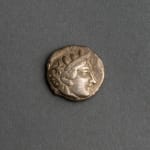Athenian Silver Tetradrachm, 449 BCE - 413 BCE
Silver
17.2 Grams
LC.264
Obverse: Helmeted Head of the Goddess Athena Reverse: Owl Standing Right with Olive Sprig and Crescent Moon Abov Athenian coinage first consisted of coins now known by the German term...
Obverse: Helmeted Head of the Goddess Athena
Reverse: Owl Standing Right with Olive Sprig and Crescent Moon Abov
Athenian coinage first consisted of coins now known by the German term or "heraldic coins," because they depicted a wide range of types once thought to be emblems of powerful Athenian families. These coins, which were not issued in large numbers and which rarely circulated outside Attica, were replaced toward the end of the sixth century B.C. by a new type of coinage, consisting primarily of tetradrachms, which became the most authoritative coinage of Classical Greece. In contrast to the constantly changing types of the , the new coins consistently depicted Athena, the patron goddess of Athens, on the obverse and her attribute the owl, a sprig of olive, and a crescent moon on the reverse. Popularly known as "owls," they were also clearly marked as Athenian, probably because they, unlike the , were intended for wide circulation. The owls were soon issued in very large numbers, thanks to the exploitation of Athens' rich silver mines at Laurion. By the time this tetradrachm was issued, almost a century had elapsed since the first owls were produced, yet the style of the types had changed very little, probably so that the consistent, unchanging nature of the issues ensured continued acceptance in foreign markets. This owl comes from the High Classical period, yet the head of Athena, with its frontal eye, patterned hair, and "archaic" smile, is archaic. These very features render fifth-century owls somewhat difficult to date, but slight changes over time allow them to be dated stylistically.
Reverse: Owl Standing Right with Olive Sprig and Crescent Moon Abov
Athenian coinage first consisted of coins now known by the German term or "heraldic coins," because they depicted a wide range of types once thought to be emblems of powerful Athenian families. These coins, which were not issued in large numbers and which rarely circulated outside Attica, were replaced toward the end of the sixth century B.C. by a new type of coinage, consisting primarily of tetradrachms, which became the most authoritative coinage of Classical Greece. In contrast to the constantly changing types of the , the new coins consistently depicted Athena, the patron goddess of Athens, on the obverse and her attribute the owl, a sprig of olive, and a crescent moon on the reverse. Popularly known as "owls," they were also clearly marked as Athenian, probably because they, unlike the , were intended for wide circulation. The owls were soon issued in very large numbers, thanks to the exploitation of Athens' rich silver mines at Laurion. By the time this tetradrachm was issued, almost a century had elapsed since the first owls were produced, yet the style of the types had changed very little, probably so that the consistent, unchanging nature of the issues ensured continued acceptance in foreign markets. This owl comes from the High Classical period, yet the head of Athena, with its frontal eye, patterned hair, and "archaic" smile, is archaic. These very features render fifth-century owls somewhat difficult to date, but slight changes over time allow them to be dated stylistically.



